Learning how to preserve meat without refrigeration is a skill nearly forgotten, but incredibly important.
Many families are learning the value of stocking up on food and not relying on frequent grocery runs. These days, shortages are common and prices are high.
Grocery shopping has become somewhat of a game of, “What’s out of stock today?” Nearly everyone across the country has witnessed bare shelves and seen firsthand the impact of inflation.
One thing we can do to lessen these impacts is to shop smarter, and learn how to make our food last longer. This includes thinking of creative ways to preserve our food, including meat.
While refrigeration and freezing are the easiest and most common ways to store meat, there are good reasons to look at alternatives.
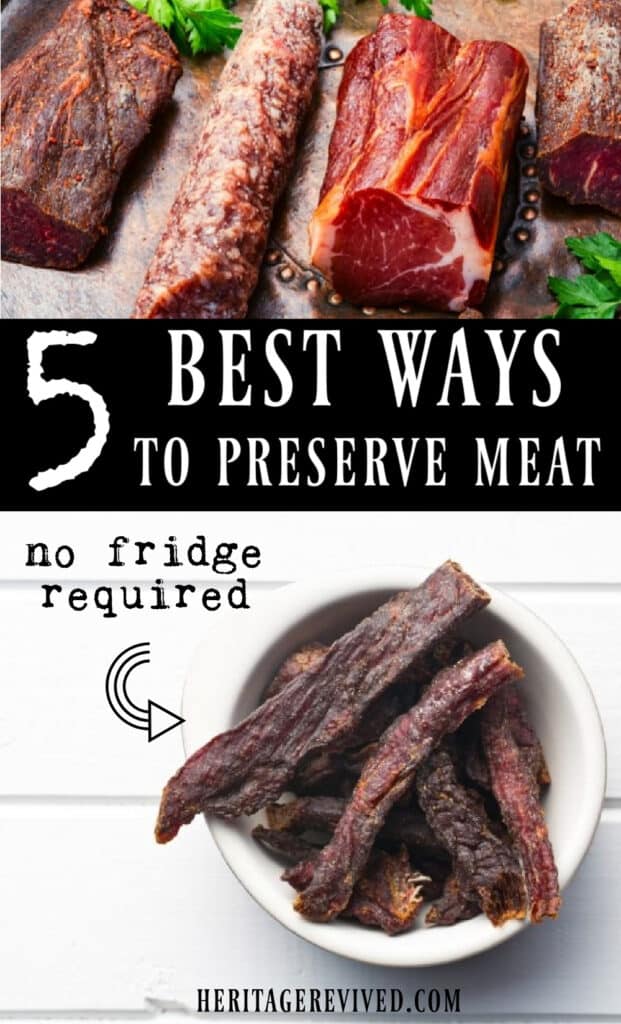
The most obvious reason is protecting our food stock from electrical outages. Rolling blackouts during peak energy usage in the summer, natural disasters and other potential crises could create a scenario where refrigeration isn’t available at times.
Think of your food storage system like an investment portfolio: it’s always best to diversify, right? By learning how to preserve meat without refrigeration, you can hedge your bets against losing, for instance, that 1/2 beef you purchased to last throughout the year.
This site contains affiliate links to products. As an Amazon associate, I earn from qualifying purchases. Please read my disclosure for more info.
Methods for preserving meat – without refrigeration
Let’s look at 5 of the best ways to think outside the (freezer) box, when it comes to preserving meats – and which might be more practical than others.
Dehydration
Drying foods for longer-term storage is a practice that goes back to ancient times. When the moisture content is adequately removed from meats, it becomes a (somewhat) shelf-stable, high-protein snack or even a meal in a pinch.
When you think of drying meats, you’re probably right to consider beef jerky and beef sticks. Those are the two that most people are familiar with and you can also find in the grocery store.
However, also think about:
- Sliced deli meats (turkey, chicken)
- Ground beef (cooked)
- Venison (ground or sliced thin and cooked)
You want to choose lean cuts of meat for dehydrating, sliced thinly. Anything with a high fat content will go rancid more quickly.
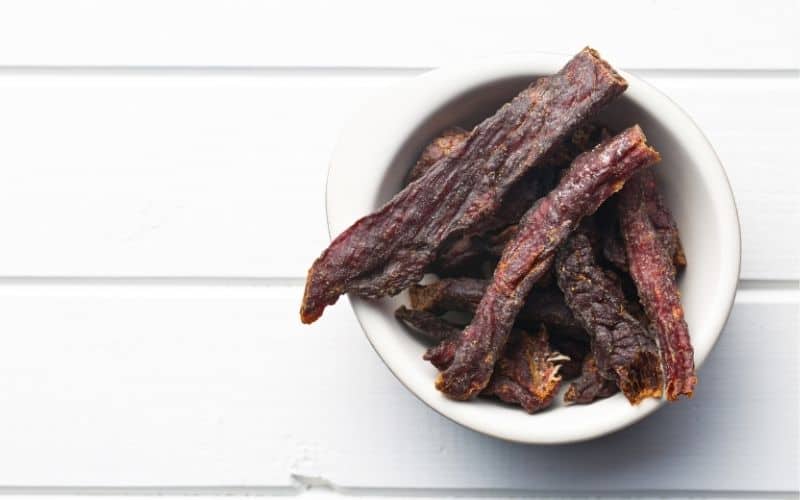
Canned meats like tuna and canned chicken can also be dehydrated but there is little benefit to dehydrating meats that are already canned, in my opinion. Canned foods will last longer and taste better in their original state.
How to dehydrate meat
Most meats can be dehydrated anywhere from about 145 degrees to 165 degrees until completely dry.
A few great options for dehydrating are:
The Excalibur dehydrators are pretty much the gold standard and are incredibly reliable. Some models have multiple trays for drying larger batches of food.
I personally love the Power XL Air Fryers that come with 5 trays. We’ve used it for dehydrating a million things, including jerky, veggies, and herbs from the garden. Best of all, I can keep it on my counter year-around and use it for multiple purposes.
How long does dehydrated meat last?
Whereas many dehydrated fruits, veggies and herbs can last around a year in a mason jar, home-dehydrated meats are a little different. They should last around a month in a cool, dark pantry.
Longer than that, you will likely need to refrigerate or freeze your dehydrated foods to preserve them (unless you have a cold room or a root cellar, of course.)
I still find dehydrated meats worthwhile, even in the freezer. In the event of a power outage, you can pop out a package for a quick meal that doesn’t need to be cooked.
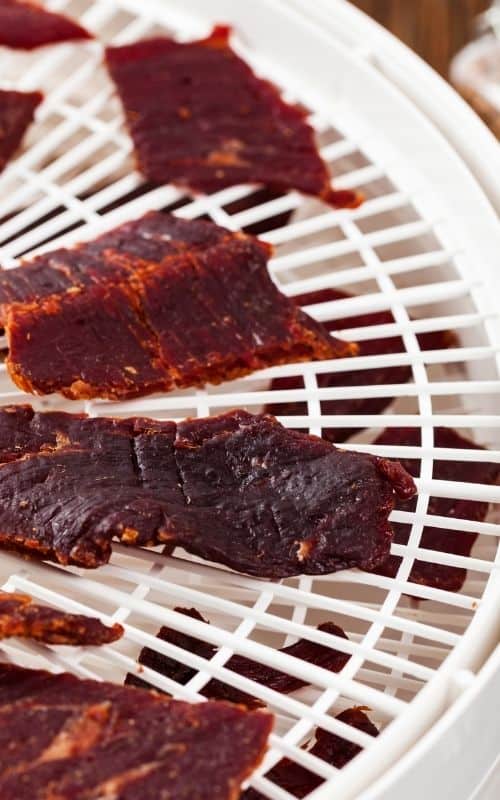
The bottom line is, for long-term storage you don’t want to dehydrate a huge amount of your meat thinking it can sit on the shelf and be safe for months or years.
But, it can make a great snack for a few weeks at a time and it’s much cheaper than buying store-bought jerky, for instance.
It’s perfect for hiking and camping. And, dehydrating can also be a great way to use up older frozen meat.
Freeze Drying
Freeze drying is the #1 way to dehydrate meats for (very) long-term storage. Once relegated to “astronaut food” or MREs (meals, ready-to-eat) utilized by the military – it’s now a very popular method for home food preservation.
How freeze drying works
Right now, the only company that provides freeze drying machines for home use is Harvest Right.
The process is pretty simple. You can freeze-dry meats, veggies, fruits, even dairy, eggs and pre-cooked meals. Simply load the food items onto the trays, push a button and dry them anywhere from 20-40 hours, depending on the product.
Afterwards, you will need to store your freeze-dried food in an airtight container such as a mylar bag or a mason jar, with an oxygen absorber.
Benefits of freeze drying meat
It’s easy to see why freeze drying has become so popular.
- Food lasts for up to 25 years
- Requires little to no prep work
- No guesswork- machine turns off when food is done
- Excellent way to preserve leftovers
- More nutrients are retained than almost any other method of preservation
- Saves money over time versus buying pre-packaged freeze-dried foods

Cons of freeze drying meat
The main downside of freeze drying is the cost, which is significant. These units will cost a few thousand dollars, and also add a small cost (a few dollars a day) to your electricity bill with the long run cycles required.
There is a small amount of maintenance (adding and changing oil, infrequently). In addition, freeze dryers take up a decent amount of space — about the size of a mini fridge, depending on the one you choose.
You should also know, they can be noisy!
The large freeze dryer requires a dedicated 20-amp circuit, so you’ll want to plan ahead if you choose this size.
In order to recoup some of the costs, some people sell their freeze dried foods and candy (online or at local markets), in addition to their own food storage. You’ll want to be sure and understand your state’s cottage laws for selling food items before diving into this venture.
Read more FAQs about freeze drying here.
Canning
Behind freezing, canning is probably the second most popular method of storing meat long term.
How to can meats
Pressure canning is considered the “only” safe way to can meats by the USDA. However, many people in other countries around the world use water-bath canning.
The problem with water bathing meats is they require such a long boil time, which means less nutrients are retained and the texture can sometimes be less appealing.
The National Center for Home Food Preservation has a guide on pressure canning all different types of meats here.
The Ball Complete Book of Home Preserving would be another great addition to your bookshelf, if you’re new to any type of canning.
My absolute favorite tool for pressure canning is the Presto 12-quart electric pressure canner. While I also think it’s good to know how to use a standard stovetop pressure canner, the electric version is super helpful for beginners and busy moms (like me).
Benefits of canning meat
Here’s what’s great about having some canned meat on the shelf:
- You can quickly put meals together from the pantry (no thawing needed)
- You have a source of protein ready to eat if the power goes out
- Food lasts for at least a few years (sources vary on this topic, but usually good for 18-24 months)
- You can save freezer space
- Canned meats are portable when camping, moving, etc.
Cons of canning meat
There are a few drawbacks of canned meat, though:
- Taste and texture can vary greatly after meat is canned. (Most people have better luck with chicken and pork, than beef and venison.)
- There is a learning curve to pressure canning to create food that is shelf-stable and safe to eat
- Jars can unseal spontaneously (not very common, but it can happen)
- Jars can be broken if not stored properly, or in an earthquake/disaster
Canning is still a tried and true method for making meats last longer and diversifying your food stock, and I highly recommend learning it!
Cold Smoke method
This is definitely not a common practice these days, but it was many years ago. If you’ve read the Little House on the Prairie series, you might remember the detailed description of Pa building a smokehouse to preserve the family’s meat for the winter.
Before smoking the meat at a low temperature (known as cold smoking), meat is cured with salt and sometimes other agents to inhibit bacterial growth (see next section on curing meat). Once the meat is cured, it is hung and smoked in the smokehouse where it dries at a low temperature for several weeks, typically.
Benefits of cold smoking meat
Cold smoking is one of the more primitive preservation techniques, and learning how to perfect this skill could be invaluable if your goal is to live off grid or without modern electricity.
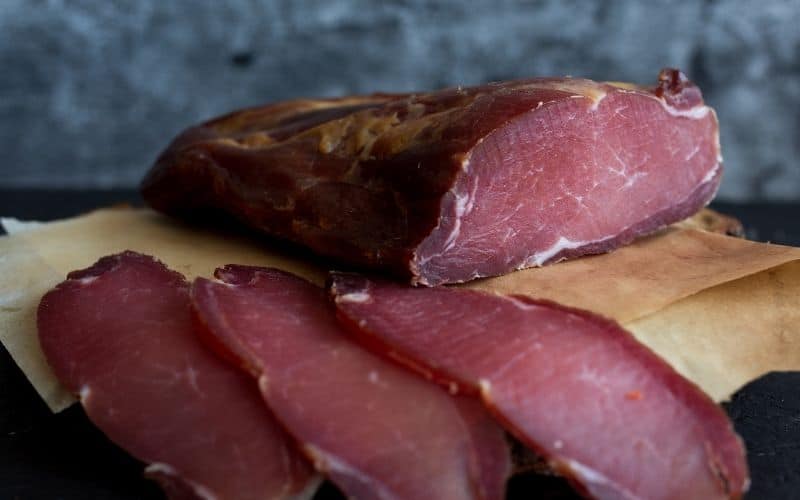
Cons of cold smoking meat
Obviously, it’s one of the most labor-intensive ways to preserve food. It takes a lot of time, practice and knowledge to perfect the cold smoking process.
You’ll also need the right materials and know-how to build your own cold smoker.
You can find several Youtube tutorials on building a smokehouse, and how to cold smoke meat, step by step.
Salt curing
There are also methods that involve salt curing without cold smoking. It’s most commonly done with fish, beef or pork today.
While it’s not a popular practice anymore, it was the way our ancestors understood how to preserve meat without refrigeration.
The only issue is that unless you live in a cold climate, you will need some type of refrigeration during the 1-2 weeks that it takes for the meat to cure.
Another option would be to store the meat in a root cellar or “cold room” during curing- but only if it stays at a consistently cold temperature: between 35 and 40 degrees Fahrenheit.
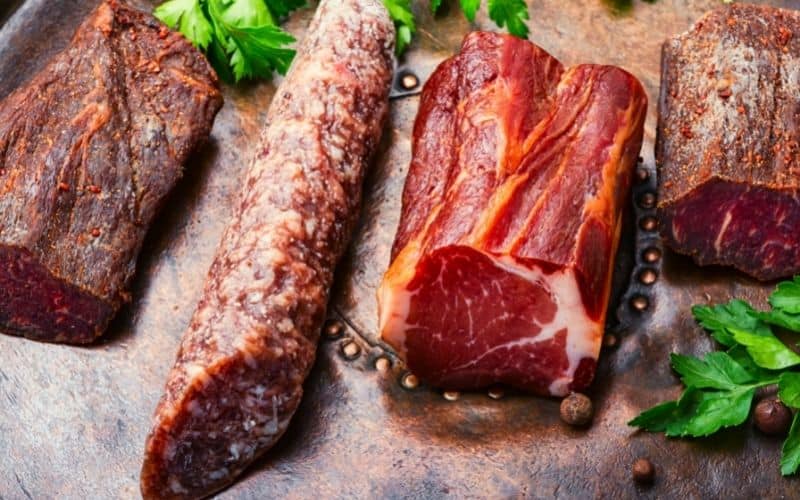
After that, the meat still needs to be stored in a cool area (also around 40 degrees F, or less). Meat then needs to be soaked in water for another day or so to remove the salt before eating.
*Note; only a few methods allow eating cured meats without cooking them afterwards. Most of the time, except for certain types of sausages, cured meats need to be cooked after curing, the same as you would with fresh meat.
Benefits of salt curing
Salt curing alone is pretty straightforward, and some meats can be preserved for a long time this way, prior to cooking.
As you know, salt is usually fairly easy to obtain, and easy to store in bulk. Salt was used for thousands of years to preserve meats, so its preservation ability is well-documented (even in the Bible).
Cons of salt curing
Like many of the age-old techniques, there is a learning curve and skill required to make sure cured foods are safe to consume.
If you’re interested in learning more about salt curing, I recommend this site which is dedicated to teaching all about cured meats.
Summary: Learning how to preserve meat without refrigeration
In short, there are many ways to learn how to keep meat longer than the fridge allows, and avoid using the freezer as well.
Some options, like freeze drying and dehydration, make meat preservation a snap, but comes with an up-front cost for the equipment.
Other options, like salt curing, are fairly simple and cheap if you know what you’re doing. However, it can take longer to learn and be confident that your meat is safe to eat. The older methods of salt curing and cold smoking are also pretty time consuming for modern schedules.
Pressure canning can be somewhat in the middle of the road in regards to skill and cost.
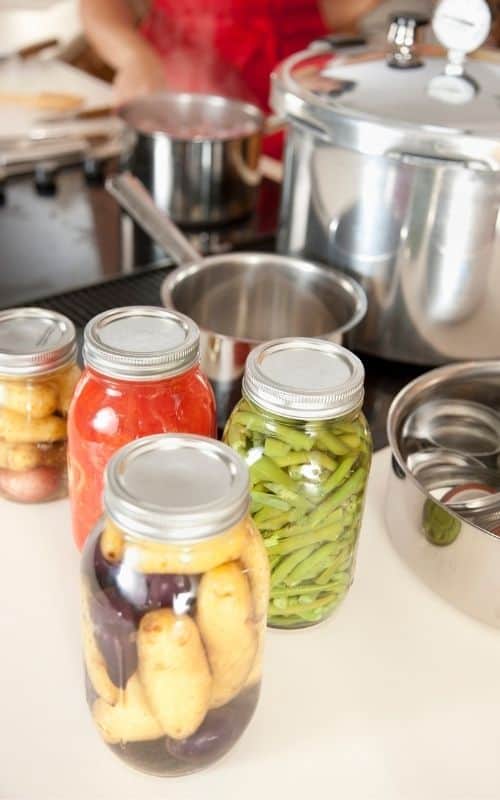
Overall, I think it’s good to have an idea of how each method of meat preservation works, and have some basic supplies on hand to store meat long-term. With supply-chain issues and other global concerns, it’s always wise to learn new food preservation methods.
We tend to assume society always progresses “upward”, but the last few years have taught us that sometimes there are hiccups or even huge disturbances along that road.
It may be time to reclaim these lost skills for more reason than one.
You might also like:
Preserving vegetables without the freezer OR refrigerator